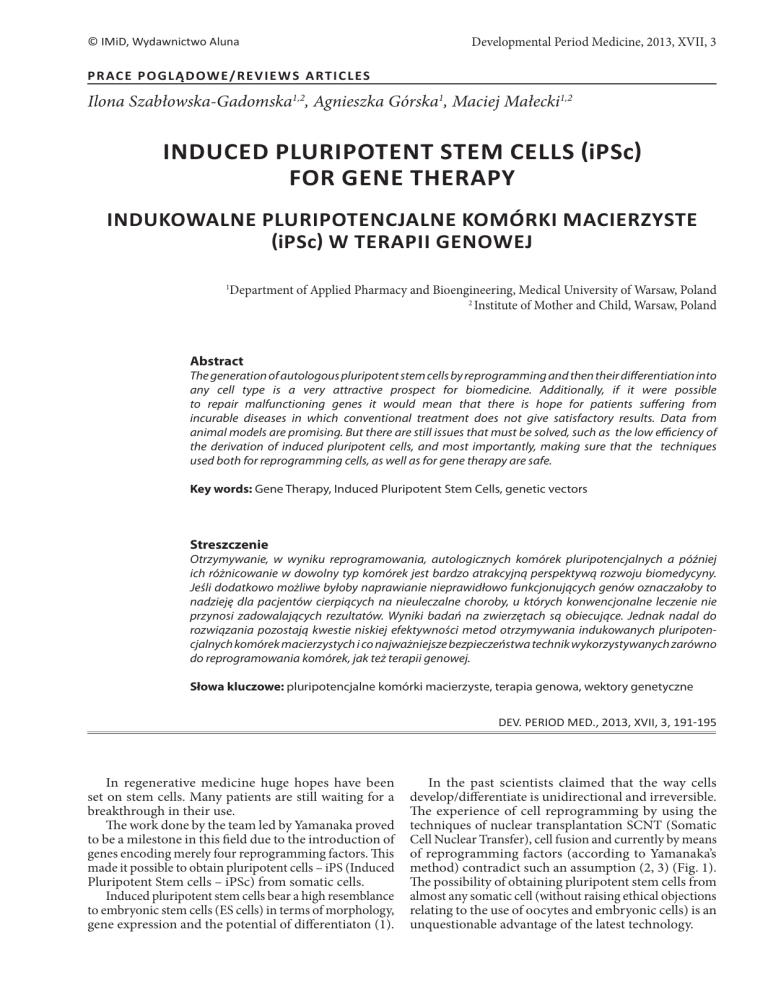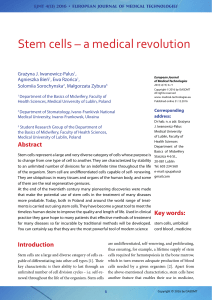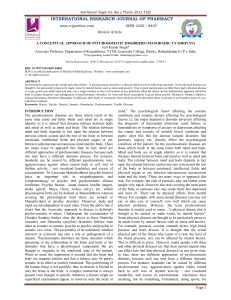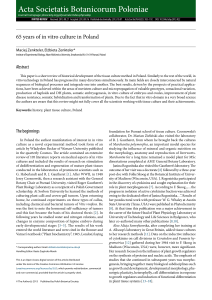
© IMiD, Wydawnictwo Aluna
Developmental Period Medicine, 2013, XVII,191
3
PR ACE POGL Ą DOWE / R E VI E W S A RTI CL ES
Ilona Szabłowska-Gadomska1,2, Agnieszka Górska1, Maciej Małecki1,2
INDUCED PLURIPOTENT STEM CELLS !iPSc"
FOR GENE THERAPY
INDUKOWALNE PLURIPOTENCJALNE KOMÓRKI MACIERZYSTE
!iPSc" W TERAPII GENOWEJ
1
Department of Applied Pharmacy and Bioengineering, Medical University of Warsaw, Poland
2
Institute of Mother and Child, Warsaw, Poland
Abstract
The generation of autologous pluripotent stem cells by reprogramming and then their differentiation into
any cell type is a very attractive prospect for biomedicine. Additionally, if it were possible
to repair malfunctioning genes it would mean that there is hope for patients suffering from
incurable diseases in which conventional treatment does not give satisfactory results. Data from
animal models are promising. But there are still issues that must be solved, such as the low efficiency of
the derivation of induced pluripotent cells, and most importantly, making sure that the techniques
used both for reprogramming cells, as well as for gene therapy are safe.
Key words: Gene Therapy, Induced Pluripotent Stem Cells, genetic vectors
Streszczenie
Otrzymywanie, w wyniku reprogramowania, autologicznych komórek pluripotencjalnych a później
ich różnicowanie w dowolny typ komórek jest bardzo atrakcyjną perspektywą rozwoju biomedycyny.
Jeśli dodatkowo możliwe byłoby naprawianie nieprawidłowo funkcjonujących genów oznaczałoby to
nadzieję dla pacjentów cierpiących na nieuleczalne choroby, u których konwencjonalne leczenie nie
przynosi zadowalających rezultatów. Wyniki badań na zwierzętach są obiecujące. Jednak nadal do
rozwiązania pozostają kwestie niskiej efektywności metod otrzymywania indukowanych pluripotencjalnych komórek macierzystych i co najważniejsze bezpieczeństwa technik wykorzystywanych zarówno
do reprogramowania komórek, jak też terapii genowej.
Słowa kluczowe: pluripotencjalne komórki macierzyste, terapia genowa, wektory genetyczne
DEV. PERIOD MED., 2013, XVII, 3, 191195
In regenerative medicine huge hopes have been
set on stem cells. Many patients are still waiting for a
breakthrough in their use.
The work done by the team led by Yamanaka proved
to be a milestone in this field due to the introduction of
genes encoding merely four reprogramming factors. This
made it possible to obtain pluripotent cells – iPS (Induced
Pluripotent Stem cells – iPSc) from somatic cells.
Induced pluripotent stem cells bear a high resemblance
to embryonic stem cells (ES cells) in terms of morphology,
gene expression and the potential of differentiaton (1).
In the past scientists claimed that the way cells
develop/differentiate is unidirectional and irreversible.
The experience of cell reprogramming by using the
techniques of nuclear transplantation SCNT (Somatic
Cell Nuclear Transfer), cell fusion and currently by means
of reprogramming factors (according to Yamanaka’s
method) contradict such an assumption (2, 3) (Fig. 1).
The possibility of obtaining pluripotent stem cells from
almost any somatic cell (without raising ethical objections
relating to the use of oocytes and embryonic cells) is an
unquestionable advantage of the latest technology.
192
Ilona Szabłowska-Gadomska i wsp.
ReprogrammingIReprogramowanie
Oocyte/Oocyt
ES cell/Zarodkowa komórka macierzysta
Somatic cell/Komórka somatyczna
SCNT
ES cell/Zarodkowa komórka macierzysta
Heterocarion/Heterokarion
or/lub
Hybrids/ Hybrydy
Somatic cell/Komórka somatyczna
Cell fusion / Fuzja komórek
Reprogramming factors/
Czynniki Reprogramujące
Induced Pluripotent Stem Cells – iPS
Indukowana pluripotencjalna komórka macierzysta – iPS
Somatic cell/
Komórka somatyczna
by Yamanaka’s method / metodą Yamanaki
Fig. 1. Strategy of cell reprogrammining.
Ryc. 1. Strategie reprogramowania komórek.
The most valuable feature of pluripotent stem cells
(including iPS cells) is their ability to divide, self-renew,
as well as the potential to differentiate into cells of
three germ layers. The same properties are exhibited
by node cells isolated from embryonic ICM (Inner Cell
Mass) at the blastocyst stage. The attributes of these
cells enable the production of all the body building
tissues. A greater potential is exhibited only by totipotent
cells (zygote) which, in addition to body building cells,
are also able to create extra-embryonic structures. In
order to derive iPS cells, the latest techniques are used,
which are applied, among other things, in gene therapy
(Fig. 2). The introduction of nucleic acids encoding the
reprogramming factors (in order to obtain pluripotent
stem cells) can be done with different types of vectors. The
most effective method, which is unfortunately burdened
with the highest risk of oncogenesis and potential
reactivation of transgenes during cell differentiation,
is based on the use of retro and lentiviruses. In both
systems amplification of transgenes often entails the
integration of the virus vector into the genome of a cell
undergoing the reprogramming process (the host cell).
Using a lentivirus vector makes it possible to introduce
genes into non-dividing cells (4). As far as clinical
application is concerned, “integration free” methods
that enable the amplification of the gene that is being
introduced independent of the material located on the
chromosomes of the host cell, are more secure. When
introduced into cells, adenoviral vectors exist in episomal
form and allow a high but transient expression level
(4, 5). The methods for introducing genetic material
into cells can also be classified into those based on
viral and non-viral vectors. Amidst the latter, there
are some interesting strategies based on “PiggyBAC”
and “minicircle” plasmids (6).
When considering methods of cell reprogramming,
control of the expression of the genes introduced is a
crucial aspect to be taken into account (particularly the
way of gene silencing). The aforementioned PiggyBAC
system (PB) is the mobile genetic element and due to
transposase enzyme activity not only makes it possible
to insert sequences but also to cut them (7). Removing
the transgene can also take place through the Cre-loxP
strategy, in which the use of Cre recombinase can cut the
inserted sequences located between the loxP sequences
(8).
The strategy of recombinant/reprogramming proteins
is the alternative to the above-mentioned techniques of
gene introduction. In order to induce the endogenous
expression of the genes associated with pluripotency,
Induced Pluripotent Stem Cells (iPSc) for gene therapy
193
Differentiation/
Różnicowanie
Reprogramming factors/
Czynniki reprogramujace
Reprogramming/
Reprogramowanie
Endoderm cells/
Komórki endodermy
Somatic cell/
Komórka somatyczna
Mesoderm cells/
Komórki mezodermy
plasmid/
plazmid
Virus/
wirusy
mRNA
Ectoderm cells/
Komórki ektodermy
Reprogramming protein/
Białka reprogramujące
Small molecules/
Małe związki
Fig. 2. Manufacturing of iPS cells.
Ryc. 2. Otrzymywanie komórek iPS.
two research teams (Kim’s and Ding’s) introduced four
protein transcription factors OCT4, SOX2, KLF4 and
C-MYC with attached polyarginine tails into the cell
(9, 10). The polyarginine domains associated with the
proteins introduced make it easier to overcome the barrier
membrane. This mechanism also applies to naturally
occurring peptides rich in arginine and lysine, therefore
these proteins are called CPP (Cell Penetrating Peptide)
(11).
However, all these methods exhibit a very low efficiency
as opposed to strategies based on retroviruses, as well as
lentiviruses and require multiple and time–consuming
tests.
A different reprogramming strategy using synthetic
mRNA was proposed by Warren and his team. This method
is as good as integration techniques in terms of efficiency
(5, 6). However, it carries a risk of malignancy as a result
of such factors as, for example, over expression of MYC
introduced to function not only as a reprogramming
factor but also as a proto-oncogene, known for its cell
proliferation. (12).
In the case of gene therapy the most commonly used
vectors include promoters allowing the constitutive
expression of genes, which significantly limits the regulation/
control of expression of the transgene transcription.
Nowadays, there are successfully made attempts to use
adjustable promoters of genes whose activity depends on,
inter alia, the pharmacological stimulation of cells. The
other promoters, such as tissue - specific ones, arouse
interest as well. In particular, great hopes have been
reposed in the use of these methods for ischemic disease
treatment – a field in which many positive results have
been documented (13).
As an example, iPS cells may be generated from the
skin cells of patients with neurodegenerative diseases and
then used as material for gene therapy. Afterwards, they
may be implanted into patients after the manipulations
associated with the repair and after differenciation into
the congruent type of cells (14) (Fig. 3).
So far iPS cells have successfully been derived from
patients with diseases like Huntington’s, Parkinson’s,
Duchenne dystrophy or Amyotrophic Lateral Sclerosis
(ALS) (16).
A lot of information is provided from animal testing.
Succesful examples include a completed study of the
model of sickle cell disease. Hanna et al. (17) obtained
iPS cells from mice cells which exhibited a genetic defect.
These cells were then “fixed” and, after differentiation,
implanted back into mice that showed improvement,
afterwards.
Gene therapy may be an alternative form of treatment
for patient with diseases such as congenital or single gene
disorders, or cancer, especially when pharmacological or
surgical intervention does not give good results (4, 18). In
194
Ilona Szabłowska-Gadomska i wsp.
Gene therapy/
Terapia genowa
Normal pre-differentiated cells/
Komórki prawidłowe podróżnicowane
Au
to
Tra
ns
log
pla
ous
iPS – normal cells/
iPS – komórki prawidłowe
tra
nsp
l
iPS – altered cells/
iPS – komórki nieprawidłowe
ant
nta
cja
Norma pre-differentiated cells/
Komórki prawidłowe podróżnicowane
atio
n
aut
olo
g
iczn
a
Altered somatic cells/
Komórki somatyczne
– nieprawidłowe
Normal somatic cells/
Komórki somatyczne – prawidłowe
iPS – normal cells/
iPS – komórki prawidłowe
Patient/
Pacjent
Fig. 3. Poten!al applica!ons of iPS cells for biomedicine.
Ryc. 3. Potencjalne wykorzystanie komórek iPS w biomedycynie.
the future, induced pluripotent stem cells in combination
with gene therapy may enhance the progress in treatment.
Future work should focus on research in improving the
methods of obtaining iPS cells, as well as gene therapy
techniques in order to become more effective and safe
for patients.
REFERENCES
1. Takahashi K., Yamanaka S.: Induction of pluripotent stem
cells from mouse embryonic and adult fibroblast cultures
by defined factors cell, 2006, 126, 663-676.
2. Ladewig J, Koch P, Brüstle O.: Leveling Waddington: the
emergence of direct programming and the loss of cell fate
hierarchies. Nat. Rev. Mol. Cell. Biol. 2013, Apr, 14(4),
225-236.
3. Yananaka S., Blau H.N.: Nuclear reprogramming to a
pluripotent state by three approaches, Nature 10, 2010,
704-712.
4. Józkowicz A., Dulak J.: Nowe strategie wykorzystania
wektorów plazmidowych i wirusowych w terapii genowej,
Biotechnologia 3, 78, 2007,7-21.
5. Gonzalez F., Boue S., Belmonte J.C.I.: Methods for making
induced pluripotent stem cells: reprograming a la carte,
Nature Reviews Genetics, 2011, 1-12.
6. Oh S., Lee C.K., Cho K.J., Lee K., Cho S., Hong S.: Technological
Progress in Generation of Induced Pluripotent Stem Cells
for Clinical Applications, The Scientific World Journal,
2012, 1-10.
7. Woltjen K., Michael I.P., Mohseni P., Desai R., Mileikovsky M.,
Hämäläinen R., Cowling R., Wang W., Liu P., Gertsenstein
M., Kaji K., Sung H.K., Nagy A.: PiggyBac transposition
reprograms fibroblasts to induced pluripotent stem cells,
Nature, 2009, Apr 9, 458(7239), 766-770.
8. Soldner F., Hockemeyer D., Beard C., Gao Q., Bell G.W.,
Cook E.G., Hargus G., Blak A., Cooper O., Mitalipova M.,
Isacson O., Jaenisch R.: Parkinson’s Disease Patient-Derived
Induced Pluripotent Stem Cells Free of Viral Reprogramming
Factors. Cell, 2009, 136, 964-977.
9. Zhou H., Wu S., Joo J.Y., Zhu S., Han D.W., Lin T., Trauger
S., Bien G., Yao S., Zhu Y., Siuzdak G., Schöler H.R., Duan
L., Ding S.: Generation of induced pluripotent stem cells
using recombinant proteins, Cell Stem Cell, 2009, May 8,
4(5), 381-384.
10. Kim J.B., Greber B., Araúzo-Bravo M.J., Meyer J., Park K.I.,
Zaehres H., Schöler H.R.: Direct reprogramming of human
neural stem cells by OCT4. Nature, 2009, 461(7264), 649653.
11. Ziegler A., Nervi P., Dürrenberger M., Seelig J.: The Cationic
Cell-Penetrating Peptide CPPTAT Derived from the HIV-1
Protein TAT Is Rapidly Transported into Living Fibroblasts:
Optical, Biophysical, and Metabolic Evidence. Biochemistry.
2005, 44 (1), 138-148.
Induced Pluripotent Stem Cells (iPSc) for gene therapy
13. Bernard S., Eilers M.: Control of cell proliferation and
growth by Myc proteins, Results Probl. Cell Differ, 2006,
42, 329-342.
14. Malecki M., Kolsut P., Proczka R.: Angiogenic and antyangiogenic
gene therapy. Gene Therapy 2005, 12, 159-169.
15. Gibson S., Gao G., McDonalds K., Shen S.: Progress on
stem cell research towards the treatment of Parkinson’s
disease, Stem Cell Research & Therapy, 2012, 3-11.
16. Arnold A., Naaldijk Y., Fabian C., Wirth H., Binder H.,
Nikkhah G., Armstrong L., Stolzing A.: Reprogramming
of Human Huntington Fibroblasts Using mRNA, ISRN
Cell Biology, 2012, 1-7.
17. Archacka K., Grabowska I., Ciemerych M.: Indukowane
Komórki Pluripotentne – Nadzieje, Obawy i Perspektywy,
Postępy Biologii Komórki, 2010, 41-62.
18. Hanna J., Wernig M., Markoulaki S., Sun C., Meissner A.,
Cassady J., Beard C., Brambink T., Wu L., Townes T., Jaenisch R.:
195
Treatment of Sickle Cell Anemia Mouse Model with iPS
Cells Generated from Autologous Skin, Science 21, vol
318, 2007, 1920-1923.
19. Małecki M., Janik P.: Terapia genowa w klinice, Współczesna
Onkologia, 2004, vol. 8, 3, 119-123.
Author’s contributions/Wkład Autorów
According to the order of the Authorship/Według kolejności
Conflicts of interest/Konflikt interesu
The Authors declare no conflict of interest.
Autorzy pracy nie zgłaszają konfliktu interesów.
Received/Nadesłano: 09.07.2013 r.
Accepted/Zaakceptowano: 06.08.2013 r.
Published online/Dostępne online
Address for correspondence:
Maciej Małecki
Department of Applied Pharmacy and Bioengineering,
Medical University of Warsaw
Banacha 1, 02-097 Warsaw, Poland
tel. 0048 572-09-65
e-mail: [email protected]



